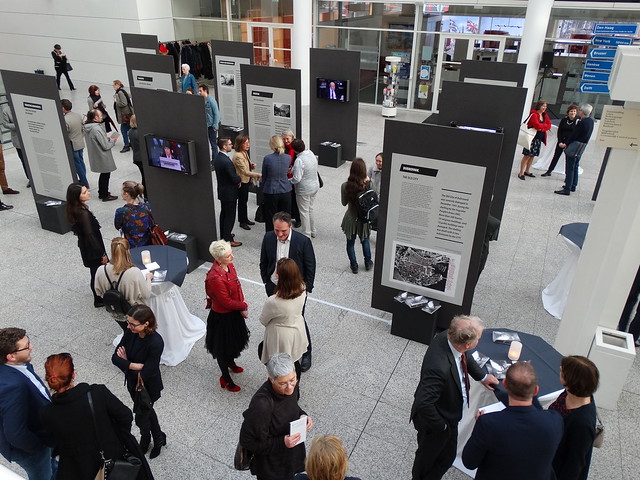Exhibition ‘Targeting Monuments – Targeting History and Memory’ opens in The Hague
The exhibition ‘Targeting Monuments – Targeting History and Memory’, which raises awareness of the deliberate destruction of cultural heritage during the 1991-1999 wars in the former Yugoslavia, was launched on 4 April at the Atrium of the City Hall of The Hague. Judge Carmel Agius, former President of the International Criminal Tribunal for the former Yugoslavia (ICTY) opened the exhibition. As a supporting partner of the European project ‘Targeting History and Memory’ and its related exhibition, Europa Nostra was represented at the event by its Secretary General Sneška Quaedvlieg-Mihailović.
Branka Benčić, Curator of the exhibition, and Mina Vidakovic, Deputy Director of SENSE – Centre for Transitional Justice, on behalf of its Director Mirko Klarin, and Geert Dijkstra, Senior International Advisor at The Hague Municipal Department of International Affairs, also addressed the audience.
“The destruction of cultural heritage or property is a crime designed to strike at the very identity of people which constitute a crime against humanity. This exhibition relates to a significant aspect of the ICTY’s work, which must and will remain relevant and impactful well beyond the closure of the Tribunal,” stated Judge Carmel Agius.
The exhibition is based on the interactive narrative ‘Targeting History and Memory’, which shows the way in which crimes against cultural, historical and religious heritage were investigated, reconstructed and processed at the ICTY based in The Hague. “With narratives like this one, we are trying to make visible, easily understandable and widely accessible the heritage of the ICTY,” said Mina Vidaković.
Sneška Quaedvlieg-Mihailović highlighted the importance of putting this project in a wider European context, especially when we celebrate the European Year of Cultural Heritage 2018. “This is the perfect occasion to emphasise the value of our shared history, our shared memory and our shared cultural heritage for shaping a more peaceful and more cohesive Europe,” she stated.
“Shock, sadness and grief are the first reactions when faced with the panels of this exhibition, which share a few lessons with us. The first lesson is that cultural heritage is a very powerful asset. It can be a resource and inspiration for art, cohesive societies, sustainable development and innovation, but also a dangerous weapon. The second lesson is that we must give a much stronger political priority to culture and education with adequate policy and funding”, advocated the Secretary General of Europa Nostra.
In his opening remarks, Geert Dijkstra recognised the importance of raising people’s awareness of the multiple threats to cultural heritage across Europe, and stressed that the “preservation of cultural heritage requires combined efforts to bring peace, justice and people together”.
The European project ‘Targeting History and Memory’ has been developed and implemented by SENSE – Centre for Transitional Justice (Pula, Croatia) and Documenta – Centre for Dealing with the Past (Zagreb, Croatia) together with the Humanitarian Law Centre (Belgrade, Serbia) and the Historical Museum of Bosnia and Herzegovina (Sarajevo). It was made possible thanks to the support of the ‘Europe for Citizens’ (European Remembrance) programme of the European Union and the Dutch Ministry of Foreign Affairs.
After a series of exhibitions held in 2017 in Belgrade, Sarajevo, Zagreb and Pula, the final exhibition is on view in The Hague until 16 April.







